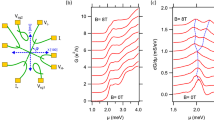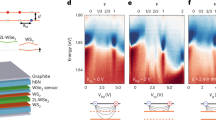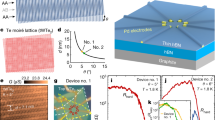Abstract
Semiconductor heterostructures1 and ultracold neutral atomic lattices2 capture many of the essential properties of one-dimensional electronic systems. However, fully one-dimensional superlattices are highly challenging to fabricate in the solid state due to the inherently small length scales involved. Conductive atomic force microscope lithography applied to an oxide interface can create ballistic few-mode electron waveguides with highly quantized conductance and strongly attractive electron–electron interactions3. Here we show that artificial Kronig–Penney-like superlattice potentials can be imposed on such waveguides, introducing a new superlattice spacing that can be made comparable to the mean separation between electrons. The imposed superlattice potential fractures the electronic subbands into a manifold of new subbands with magnetically tunable fractional conductance. The lowest plateau, associated with ballistic transport of spin-singlet electron pairs3, shows enhanced electron pairing, in some cases up to the highest magnetic fields explored. A one-dimensional model of the system suggests that an engineered spin–orbit interaction in the superlattice contributes to the enhanced pairing observed in the devices. These findings are an advance in the ability to design new families of quantum materials with emergent properties and the development of solid-state one-dimensional quantum simulation platforms.
This is a preview of subscription content, access via your institution
Access options
Access Nature and 54 other Nature Portfolio journals
Get Nature+, our best-value online-access subscription
$29.99 / 30 days
cancel any time
Subscribe to this journal
Receive 12 print issues and online access
$209.00 per year
only $17.42 per issue
Buy this article
- Purchase on Springer Link
- Instant access to full article PDF
Prices may be subject to local taxes which are calculated during checkout




Similar content being viewed by others
Data availability
Source data are available at the Harvard Dataverse38. Other data and code that support the findings of this study are available from the corresponding author upon reasonable request.
References
Byrnes, T., Kim, N. Y., Kusudo, K. & Yamamoto, Y. Quantum simulation of Fermi-Hubbard models in semiconductor quantum-dot arrays. Phys. Rev. B 78, 075320 (2008).
Jaksch, D. & Zoller, P. The cold atom hubbard toolbox. Ann. Phys. 315, 52–79 (2005).
Annadi, A. et al. Quantized ballistic transport of electrons and electron pairs in LaAlO3/SrTiO3 nanowires. Nano Lett. 18, 4473–4481 (2018).
Feynman, R. P. Simulating physics with computers. Int. J. Theor. Phys. 21, 467 (1982).
Mazurenko, A. et al. A cold-atom Fermi–Hubbard antiferromagnet. Nature 545, 462–466 (2017).
Choi, J.-Y. et al. Exploring the many-body localization transition in two dimensions. Science 352, 1547–1552 (2016).
Porras, D. & Cirac, J. I. Effective quantum spin systems with trapped ions. Phys. Rev. Lett. 92, 207901 (2004).
Houck, A. A., Türeci, H. E. & Koch, J. On-chip quantum simulation with superconducting circuits. Nat. Phys. 8, 292–299 (2012).
Politi, A., Matthews, J. C. F. & O’Brien, J. L. Shor’s quantum factoring algorithm on a photonic chip. Science 325, 1221 (2009).
Singha, A. et al. Two-dimensional Mott–Hubbard electrons in an artificial honeycomb lattice. Science 332, 1176–1179 (2011).
Slot, M. R. et al. Experimental realization and characterization of an electronic Lieb lattice. Nat. Phys. 13, 672–676 (2017).
Drost, R., Ojanen, T., Harju, A. & Liljeroth, P. Topological states in engineered atomic lattices. Nat. Phys. 13, 668–671 (2017).
Cen, C. et al. Nanoscale control of an interfacial metal–insulator transition at room temperature. Nat. Mater. 7, 298–302 (2008).
Cen, C., Thiel, S., Mannhart, J. & Levy, J. Oxide nanoelectronics on demand. Science 323, 1026–1030 (2009).
Kronig, R. D. L. & Penney, W. G. Quantum mechanics of electrons in crystal lattices. Proc. R. Soc. A 130, 499–513 (1931).
Pai, Y.-Y., Tylan-Tyler, A., Irvin, P. & Levy, J. Physics of SrTiO3-based heterostructures and nanostructures: a review. Rep. Prog. Phys. 81, 036503 (2018).
Cheng, G. et al. Electron pairing without superconductivity. Nature 521, 196–199 (2015).
Briggeman, M. et al. Pascal conductance series in ballistic one-dimensional LaAlO3/SrTiO3 channels. Science 367, 769–772 (2020).
Cheng, G. et al. Tunable electron-electron interactions in LaAlO3/SrTiO3 nanostructures. Phys. Rev. X 6, 041042 (2016).
Glazman, L. I. & Khaetskii, A. V. Nonlinear quantum conductance of a lateral microconstraint in a heterostructure. Europhys. Lett. 9, 263 (1989).
Patel, N. K. et al. Ballistic transport in one dimension: additional quantisation produced by an electric field. J. Phys. Condens. Matter 2, 7247 (1990).
Tsui, D. C., Stormer, H. L. & Gossard, A. C. Two-dimensional magnetotransport in the extreme quantum limit. Phys. Rev. Lett. 48, 1559 (1982).
Thomas, K. J. et al. Possible spin polarization in a one-dimensional electron gas. Phys. Rev. Lett. 77, 135 (1996).
van Wees, B. J. et al. Quantized conductance of point contacts in a two-dimensional electron gas. Phys. Rev. Lett. 60, 848 (1988).
Wharam, D. A. et al. One-dimensional transport and the quantisation of the ballistic resistance. J. Phys. C 21, L209 (1988).
Bauer, F. et al. Microscopic origin of the ‘0.7-anomaly’ in quantum point contacts. Nature 501, 73–78 (2013).
Gul, Y., Holmes, S. N., Myronov, M., Kumar, S. & Pepper, M. Self-organised fractional quantisation in a hole quantum wire. J. Phys. Condens. Matter 30, 09LT01 (2018).
Kumar, S. et al. Zero-magnetic field fractional quantum states. Phys. Rev. Lett. 122, 086803 (2019).
Oreg, Y., Sela, E. & Stern, A. Fractional helical liquids in quantum wires. Phys. Rev. B 89, 115402 (2014).
Shavit, G. & Oreg, Y. Fractional conductance in strongly interacting 1D systems. Phys. Rev. Lett. 123, 036803 (2019).
Shavit, G. & Oreg, Y. Modulation induced transport signatures in correlated electron waveguides. SciPost Phys. 9, 51 (2020).
Briggeman, M. et al. Engineered spin-orbit interactions in LaAlO3/SrTiO3-based 1D serpentine electron waveguides. Sci. Adv. 6, eaba6337 (2020).
Caviglia, A. D. et al. Tunable Rashba spin-orbit interaction at oxide interfaces. Phys. Rev. Lett. 104, 126803 (2010).
Ben Shalom, M., Sachs, M., Rakhmilevitch, D., Palevski, A. & Dagan, Y. Tuning spin-orbit coupling and superconductivity at the SrTiO3/LaAlO3 interface: a magnetotransport study. Phys. Rev. Lett. 104, 126802 (2010).
Kim, Y., Lutchyn, R. M. & Nayak, C. Origin and transport signatures of spin-orbit interactions in one- and two-dimensional SrTiO3-based heterostructures. Phys. Rev. B 87, 245121 (2013).
Nethwewala, A. et al. Inhomogeneous energy landscape in LaAlO3/SrTiO3 nanostructures. Nanoscale Horiz. 4, 1194–1201 (2019).
Cheng, G. et al. Sketched oxide single-electron transistor. Nat. Nanotechnol. 6, 343–347 (2011).
Briggeman, M. Replication data for: one-dimensional Kronig-Penney superlattices at the LAOSTO interface. Harvard Dataverse https://doi.org/10.7910/DVN/8IJ4QD (2021).
Acknowledgements
J. Levy acknowledges support from a Vannevar Bush Faculty Fellowship (N00014-15-1-2847) and the National Science Foundation (PHY-1913034). Work at the University of Wisconsin was supported by funding from the DOE Office of Basic Energy Sciences under award number DE-FG02-06ER46327 (C.B.E). F.D. and A.J.D. acknowledge support from the EPSRC Programme Grant DesOEQ (EP/P009565/1) and the AFOSR (FA9550-18-1-0064). F.D. acknowledges the Belgian F.R.S.-FNRS for financial support.
Author information
Authors and Affiliations
Contributions
M.B., P.I. and J. Levy conducted the experiments. F.D., E.M. and A.J.D. made the theoretical model calculations. J. Li and M.H. processed the samples. H.L., J.-W.L., K.E. and C.-B.E. synthesized the thin films and performed structural and electrical characterizations. All the authors reviewed the manuscript.
Corresponding author
Ethics declarations
Competing interests
The authors declare no competing interests.
Additional information
Peer review information Nature Physics thanks Jung-Woo Yoo and the other, anonymous, reviewer(s) for their contribution to the peer review of this work.
Publisher’s note Springer Nature remains neutral with regard to jurisdictional claims in published maps and institutional affiliations.
Extended data
Extended Data Fig. 1 Magnetotransport data for vertical superlattice Device B1.
a, Transconductance map dG/dVsg as a function of side gate voltage Vsg and magnetic field B. Purple regions indicate conductance plateaus, zero transconductance. Red/yellow/green/blue regions indicate increases in conductance when new subbands become available. White regions indicate negative transconductance. Colored boxes are guides to the eye indicating the location of highlighted conductance curves. b, Plot showing full conductance data. Conductance curves at 1 T intervals are highlighted in black and are offset for clarity. c-e, Conductance G as a function of side gate voltage Vsg curves at different out-of-plane magnetic field B values highlighting some fractional conductance features. T=15 mK.
Extended Data Fig. 2 Device B1 1.8 Feature.
a, Conductance data - same as shown in Extended Data Fig. 1b. b, Zoom on region highlighting feature at G ≈ 1.8e2/h. Red lines are guides to the eye to show that the feature near 1.6 is in fact 0.2 below the 2e2/h plateau, which itself is not fully resolved until the highest magnetic fields.
Extended Data Fig. 3 Magnetotransport data for vertical superlattice Device B2.
a, Transconductance map dG/dVsg as a function of side gate voltage Vsg and magnetic field B. Purple regions indicate conductance plateaus, that is, zero transconductance. Red/yellow/green/blue regions indicate increases in conductance when new subbands become available. Colored boxes are guides to the eye indication the location of highlighted conductance curves. b, Plot showing full conductance data. Each curve is colored according to the transconductance at each side gate value (white indicates a plateau, black indicates rapidly increasing conductance). Curves are offset clarity. c, d, Conductance G as a function of side gate voltage Vsg curves at different out-of-plane magnetic field B values highlighting some fractional conductance features. T=50 mK.
Extended Data Fig. 4 Finite-bias spectroscopy.
a, Conductance G intensity map as a function of four-terminal voltage V4t and side gate voltage Vsg. Pink and blue dashed lines indicate the locations for the vertical linecuts shown in c. b, Transconductance (dG/dVsg) intensity map as a function of four-terminal voltage V4t and side gate voltage Vsg. The transconductance map shows the diamond features indicating ballistic transport in the superlattice devices. c, Vertical conductance linecuts at V4t = 0 and 90 ≈ μV. Circles indicate fractional conductance values below the (2e2)/h plateau (corresponding to the lowest diamond features visible in the transconductance map in panel b) that become half of their value at a finite bias. Curves are offset for clarity. Data shown is from Device A and taken at B = 13 T and T=15 mK.
Extended Data Fig. 5 Device B2 Finite Bias Spectroscopy.
a, Conductance G intensity map as a function of four-terminal voltage V4t and side gate voltage Vsg. Pink and blue dashed lines indicate the locations for the vertical linecuts shown in c. b, Transconductance (dG/dVsg) intensity map as a function of four-terminal voltage V4t and side gate voltage Vsg. The transconductance map shows the diamond features indicating ballistic transport in the superlattice devices. c, Vertical conductance linecuts at V4t=0 and 121 μV. Circles indicate fractional conductance values below the 2e2/h plateau (corresponding to the lowest diamond features visible in the transconductance map in panel b) that become half of their value at a finite bias. Curves are offset for clarity. Data shown is from Device B2 and taken at B = 9 T and T=50 mK.
Extended Data Fig. 6 Magnetotransport data for control electron waveguide devices.
a, Transconductance map dG/dVsg as a function of side gate voltage Vsg and magnetic field B for Device C1. Data previously published in ref. 3. b, Transconductance map for Device C2. T = 50 mK.
Extended Data Fig. 7 Superconductivity in Device A.
Conductance map G4t as a function of side gate voltage Vsg and four-terminal voltage V4t. A small increase of G4t near V4t = 0μV is associated with superconductivity. B=0 T and T = 15 mK.
Supplementary information
Supplementary Information
Device writing and measurement parameters, and theoretical model.
Rights and permissions
About this article
Cite this article
Briggeman, M., Lee, H., Lee, JW. et al. One-dimensional Kronig–Penney superlattices at the LaAlO3/SrTiO3 interface. Nat. Phys. 17, 782–787 (2021). https://doi.org/10.1038/s41567-021-01217-z
Received:
Accepted:
Published:
Issue Date:
DOI: https://doi.org/10.1038/s41567-021-01217-z
This article is cited by
-
A clean ballistic quantum point contact in strontium titanate
Nature Electronics (2023)
-
Electron pairing and nematicity in LaAlO3/SrTiO3 nanostructures
Nature Communications (2023)



